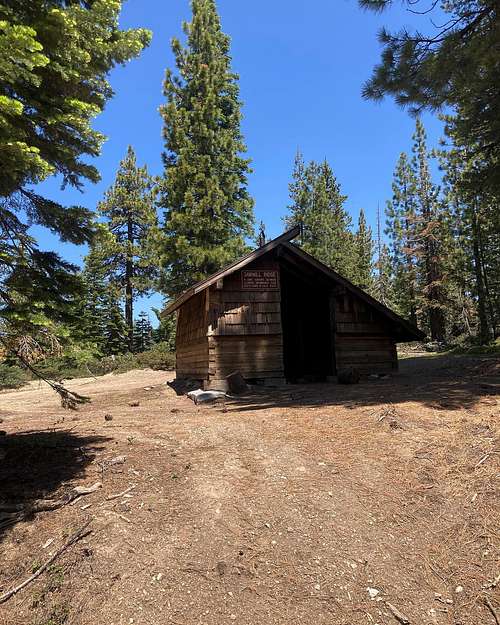-
 709 Hits
709 Hits
-
 73.06% Score
73.06% Score
-
 3 Votes
3 Votes
|
|
Mountain/Rock |
|---|---|
|
|
39.73054°N / 120.85339°W |
|
|
Plumas |
|
|
Hiking |
|
|
Spring, Summer, Fall |
|
|
7715 ft / 2352 m |
|
|
Overview
Mt. Fillmore is a fairly obscure mountain located almost exactly between Quincy and La Porte in Plumas National Forest. This peak is notable for the northern Sierra mountaineer for two reasons: 1675 feet of clean prominence (and therefore a P1K), and membership on the Tahoe Ogul peakbagging list.
Unlike the Sierra Buttes, Mt. Elwell, or Adams Peak (other far-north Sierra mountains), Mt. Fillmore does not pose a striking or recognizable summit. Nearby Mt. Etna appears larger; Mt. Fillmore's summit is more of a rolling hill that just so happens to be 700 feet higher. Approaches almost uniformly occur from the north via the Johnsville-Mcrea Road, a dirt road that connects to the paved Quincy-La Porte Road.
Getting There

Driving to Mt. Fillmore is as easy as getting on the Quincy-La Porte Road and then turning east onto the dirt Johnsville-Mcrea Road. The Quincy-La Porte Road is typically in great condition given the road is an important recreational thoroughfare for campers, fishers, and other recreators. The Johnsville-Mcrea Road is of varying quality. Up until the Delahunty Lake (approximately 2 miles from the main road), it's pretty passable. After that, high clearance is strongly recommended.
Depending on snow melt (and the last time the road was serviced), there might or might not be washout that requires 4WD. As of July 1, 2023 (when the author of this page last summited Mt. Fillmore), the road was drivable using a 2WD SUV. If you've driven other roads in the northern Sierra to mountains like English Mountain or Old Man Mountain, then you know what you're getting into. At the very least, it's easy to park near Delahunty Lake, and from there it's only a few miles of easy road walking until the ascent proper.
Please note that the Quincy-La Porte Road is paved but not plowed. In low or average snowfall years, the road is usually left to melt naturally. In high snow years (such as 2023), Plumas National Forest might plow the road to facilitate recreational use of the area. Check the Plumas National Forest closures page (linked at the end of this document) before heading out.
You can also approach Mt. Fillmore from the east by getting on Johnsville-Mcrea Road via State Road A14 and Highway I-70 from the town of Johnsville proper. However, the road is of even more variable quality, and it is a much longer drive timewise than using the Quincy-La Porte route.
Route
The most common route is approaching Mt. Fillmore from the north via the Johnsville-Mcrea Road. Simply park wherever you feel comfortable, and get ready.
- Either approach Mt. Fillmore straight from the north, or continue on a little bit to the northeast and get on the Mt. Fillmore Trail. Topo maps and apps like GaiaGPS show the Mt. Fillmore trail as a dashed line. It's an extremely easy and well-graded trail.
- When due north of the summit (check your maps!), turn south and head right on up the NNE ridge. It's easy-peasy bushwhacking that rarely requires any actual whacking.
- When you start hitting the bowl on the north slopes, turn west and ascend up the NNW ridge. (The NNE ridge gets steep fast and isn't the most pleasurable way to climb.)
- Continue taking the NNW ridge up to the summit as it curves above the treeline. There are no summit rocks, simply a smooth len for views toward Sierra Buttes, Mt. Haskell, and south toward the I-80 peaks.
The hardest part about Mt. Fillmore is driving there. If you can get to the start, then you can hike the mountain! I estimated the northern approach to be a Scrambler Rating of 1.2 (i.e. YDS Class 1) when taking the Mt. Fillmore Trail to the northern ridge. Intermediate distances of cross-country travel, but never requiring hands for stability and with completely stable footing.
Red Tape
Mt. Fillmore is located within the Plumas National Forest. There is neither fee nor permit required for entry. Dispersed camping is not allowed within designated Recreation Areas in Plumas National Forest, through which the Johnsville-Mcrea Road travels.
Nearby Delahunty Lake provides camping and RV access.
When to Climb

Climbs of Mt. Fillmore can theoretically happen any time during the year. No approaches require significant technical ability. However, access is constrained by seasonal closure of the Quincy-La Porte Road. When the road is closed, the most efficacious approaches are over 25 miles on the road proper or on the PCT. When open, the hike is barely 4 miles out-and-back if ascended from the junction of the Mt. Fillmore Trail and Johnsville-Mcrea Road. This area is not known for high-quality cross-country skiing, though I assume you could skin up the road.
In other words - you could hike Mt. Fillmore in winter, but why would you want to?
That being said, when the road is open, then Mt. Fillmore is quite easy to access regardless of snow conditions at the top. This mountain generally forms consolidated snow on the usual northern approach in Spring, so microspikes would certainly be helpful. Full crampons are rarely (if ever) needed due to the lack of significant snow.
External Links
USFS Plumas National Forest camping: link.
USFS Plumas National Forest road closures (important to read to check if Quincy-La Porte Road is open): link.

